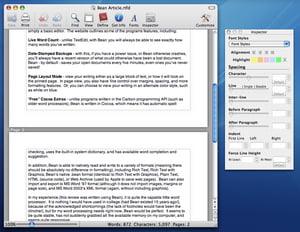Bean is a new open-source, Cocoa-based word processor for Mac. That sentence in and of itself makes it something of an anomaly in the Mac world. While there have typically been a fair number of word processing choices for Mac users (ClarisWorks/AppleWorks, Pages, Microsoft Word, Mellel, Nisus Writer Express, OpenOffice/NeoOffice, and Mariner Write), only the OpenOffice/NeoOffice combo has been free and open source, and even that has been less than ideal. OpenOffice has never been a native application for Macs, requiring instead the installation and use of the X11 graphic layer, which ends up producing an application that feels completely unnatural, and NeoOffice, while using more familiar widgets, is written in Java, which has always meant (at least to Mac users), that the application was a bit of a slowpoke.
Enter Bean. While Bean does not have nearly as many features as Microsoft Office (or the two top shareware options, Mellel and Nisus Writer Express), the fact that it looks good, is completely free, and has more features than does Apple’s free TextEdit, Bean may quickly find a place in the Applications folder of many Mac users.
Realizing that I would not find the features available in commercial word processors (the project’s website warns: “Bean is not a replacement for MS Word. It does not do footnotes or hierarchical styles, which are necessary for students and professionals. Further, it is only partially compatible with the famous .doc format of Word… Also, Bean is not a competitor for AbiWord, which is a full-featured word processor. Don’t even try to compare the two…apples and oranges.” Bean does also not support columns, text styles or floating graphics, although – as the website points out – it does support inline graphics.
So, what exactly is Bean? The website continues: “Bean is a rich text editor, with many niceties added to make writing convenient, efficient and comfortable. It is, to use a horrible clich�, Text Edit on steroids. Bean uses Apple’s very cool NSText object to do most of what it does, but it adds live word count… and the ability to adjust printed margins.”
But don’t think that Bean is only a gussied-up version of TextEdit. While it may have certain similarities (and some shared lack of features when compared to MS Word), Bean is not simply a basic editor. The website outlines some of the programs features, including:
Live Word Count – unlike TextEdit, with Bean you will always be able to see exactly how many words you’ve written.
Date-Stamped Backups – with this, if you have a power issue, or Bean otherwise crashes, you’ll always have a recent version of what could otherwise have been a lost document. Bean – by default – saves your open documents every five minutes, even ones you’ve never saved!
Page Layout Mode – view your writing either as a large block of text, or how it will look on the printed page. In page view, you also have fine control over margins, spacing, and more formatting features. Or, you can choose to view your writing in an alternate color style, such as white on blue.
Free” Cocoa Extras – unlike programs written in the Carbon programming API (such as older word processors), Bean is written in Cocoa, which means it has automatic spell checking, uses the built-in system dictionary, and has available word completion and suggestion.
In addition, Bean is able to natively read and write to a variety of formats (meaning there should be absolutely no difference in formatting), including Rich Text, Rich Text with Graphics, Bean’s native .bean format (identical to Rich Text with Graphics), Plain Text, HTML (source code), or Web Archive (used by Apple to save web pages). Bean can also import and export to MS Word ’97 format (although it does not import images, margins or page size), and MS Word 2003’s XML format (again, without including graphics).
In my experience (this review was written using Bean), it is quite the capable little word processor. It is nothing I would have used in college (had Bean existed 15 years ago!), because of the acknowledged shortcomings (the lack of footnotes would have been the clincher), but for my word processing needs right now, Bean would be perfect. It seems to be quite stable, has not suddenly grabbed all the available memory on my computer, and seems quite responsive.
One of the things I like about Bean is how customizable it is. It comes with a default set of 9 icons in the toolbar, but click on the 10th icon (Customize), and you will be shown all other options available, such as a button to bring up the fonts dialog, or one for text color, and more. Or, I can choose to have nothing in the toolbar. Similarly, while I appreciate a live word count in the status bar at the bottom of the window, some people may not care a whit for it. So, Bean allows those users to turn off the automatic word count. Bean also has the option to use “Smart Quotes” (the curly quotes often seen in printed material, as opposed to straight quotes often found on the web), or that feature can, as well, be turned off.
So, while Bean isn’t ready (by the author’s own admission) to replace MS Word, it is certainly a good step up for someone looking for a bit more control than is available from TextEdit, while wanting to spend a little less than one of the shareware options. Give Bean a try; it just might be that perfect middle option you’ve been looking for!




